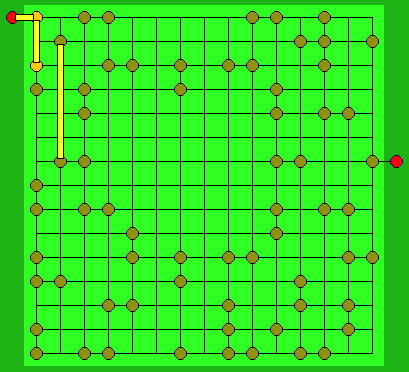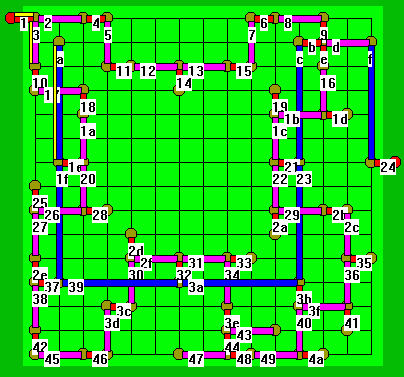The Centrifugal Force
"Hello... I recently discovered the Plank Mazes by Andrea Gilbert at the mathpuzzle.com and www.clickmazes.com web sites. I solved some of these mazes but not all. When I read the comments about Route 66 and Fiendish being the only mazes having a move/span ratio greater than one, I immediately thought that it should be possible to do better. Below is the result of my work on this idea..." (Pascal Wassong - March 2001)
Screenshot of original TCF puzzle
(not currently playable)

Background
The Centrifugal Force (TCF) was designed by Pascal to demonstrate that it is possible to attain exceedingly high move-over-span ratios by concentrating on one of the plank-puzzle's movement rules and crafting a very long solution using as fewer stumps as possible. Here are the full figures for TCF compared with Route-66 and Fiendish.
| Route-66 | Fiendish | TCF | |
|---|---|---|---|
| Grid | 9x9 (square) | 8x8 (square) | 15x15 (square) |
| Planks | 3 (1+2+3) | 4 (1+2+3+4) | 3 (1+2+5) |
| Shortest solution | 66 moves | 57 moves | 342 moves |
| Span count | 54 | 40 | 74 |
| Move/span ratio | 1.22 | 1.42 | 4.62 |
 As Pascal points out himself, TCF is not difficult to
solve. There is a big loop using the two shortest planks and
each time you move the longest plank, you open but also close
a 'valve' on this loop, which forces you to re-walk the loop.
The span diagram for TCF (right) illustrates this long loop
clearly.
As Pascal points out himself, TCF is not difficult to
solve. There is a big loop using the two shortest planks and
each time you move the longest plank, you open but also close
a 'valve' on this loop, which forces you to re-walk the loop.
The span diagram for TCF (right) illustrates this long loop
clearly.
TCF relies almost completely on the planks-cannot-cross rule to create the valve-effect, however this puzzle also illustrates one of the key plank-puzzle strategies; how it is often necessary to 'drag' a plank along so as not to lose it (even though you don't actually use it for several moves). Within the long loop (pink/red) you can see several instances of the small plank (P1/red) being dragged along by the medium plank (P2/pink).
TCF effectively illustrates that the move-over-span ratio is not a good measure of plank-puzzle difficulty. There is plenty of spare space in TCF into which additional stumps could be placed that would hide or confuse the true-path (solution) without shortening it. Effectively each additional stump increases the difficulty of the puzzle yet, by increasing the span count, automatically decreases the ratio.
I finish with a quote from Pascal... "The name of the problem comes from a famous chess retro-analysis problem by Dr. Luigi Ceriani where a King had to make a round trip on the chessboard to unlock a position ... I regularly compose chess problems. Mostly, making them difficult to solve is not what I have in mind when I compose a problem. I have generally one idea that I want to show to the solvers (or to any person interested, even if they just look at the solution). And to show an idea, it is even better that the problem is easy to solve so that one can focus on it. This is exactly what my purpose was while creating TCF : just showing one thing that can be done with these rules".
The Centrifugal Force - © Pascal Wassong - 2001

